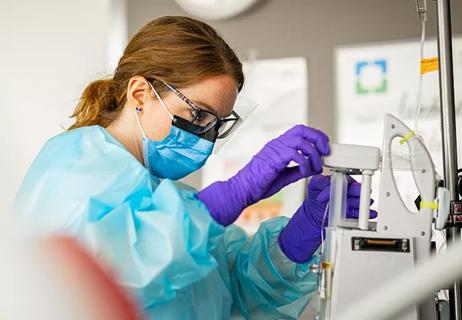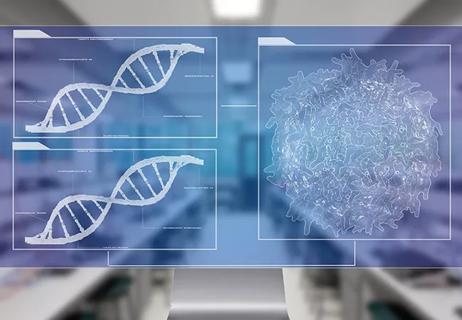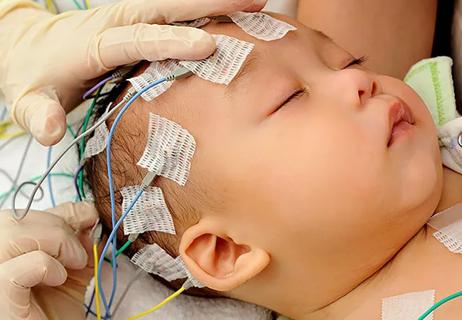Q&A with pediatric neurologist and genetics expert Neil Friedman, MBChB

Genetic disease in newborns and infants lies right at the intersection of two leading clinical and research interests of Neil Friedman, MBChB — neonatal and fetal neurology and the genetic underpinnings of pediatric neuromuscular and neurometabolic diseases.
Cleveland Clinic is a non-profit academic medical center. Advertising on our site helps support our mission. We do not endorse non-Cleveland Clinic products or services. Policy
Consult QD caught up with Dr. Friedman, who serves as Director of Cleveland Clinic’s Center for Pediatric Neurosciences, to ask a few questions on a fast-evolving field: management of critically ill newborns suspected to have a rare genetic disease.
A: The biggest revolution in medicine in the past 15 to 20 years has undoubtedly been the evolution of genetic technologies. This evolution has allowed for gene discovery, the ability to measure and analyze genetic material, and applications to patient care at faster speeds and lower costs than ever before.
About 5,000 monogenic disorders, caused by genetic variations in over 3,500 genes, have been described to date. Many of these genetic conditions are already clinically expressed during the first 28 days of life or shortly thereafter. Every year, approximately 250 new monogenic disorders are described, owing to the escalating use of genome-wide next-generation sequencing, whole-exome sequencing and whole-genome sequencing. Approximately 350 children per day are born with a genetic disease.
Disease progression in infants can be very rapid. As such, there is an imperative for genetic diagnoses to be made quickly to allow consideration of targeted interventions in a timely manner in order to decrease morbidity and reduce mortality. It is estimated that approximately 1 in 20 infants in the neonatal intensive care unit (NICU) has a genetic disease. More than 20 percent of infant deaths are caused by genetic illnesses.
The impact of neurogenetics on clinical care cannot be overstated. It allows for potential early and accurate diagnosis, thereby avoiding unnecessary investigations and enabling swift intervention for treatable conditions. Additionally, it can assist with prognosis, inform genetic counseling and help guide reproductive planning. Perhaps most importantly, it provides closure for families and an end to the diagnostic odyssey.
A: NICU treatment is exceedingly expensive, with care for critically ill infants estimated to cost approximately $8,000 per day. Despite this, NICU treatment is one of the most cost-effective types of any high-level medical care.
While the initial sequencing of the first human genome cost $1 billion and lasted 13 years (1990-2003), current costs of whole-genome sequencing (WGS) are less than $1,000. The cost of whole-exome sequencing (WES) is even lower, about $400 to $500 per sequence. New sequencing instruments also now allow for 18,000 genomes per year to be robustly sequenced. Improved software has increased the analytic sensitivity and specificity of WGS for nucleotide variants to greater than 99.5 percent. Rapid exome sequencing now allows for exome analysis in less than five days, with a median time to full genome result in about three weeks. WGS can be accomplished in seven to 10 days.
When critically applied to sick infants in the NICU and pediatric intensive care unit (PICU), the diagnostic rate is between 35 and 60 percent — approximately 50 to 75 percent higher than for infants who undergo standard investigations, which can take weeks to months. In one recent study, atypical and unrecognized presentation of genetic disorders occurred in 38 percent of the infants diagnosed by WGS. Equally important, medical management was impacted in more than 70 percent of the infants.
A: The benefits to rapid exome sequencing include improved diagnostic and management ability for vulnerable, critically ill infants in the NICU and PICU. Given that disease progression can be very rapid in infants, rapid exome sequencing allows for an extremely quick turnover and potentially precise diagnosis, thereby enabling timely, targeted and appropriate interventions to decrease morbidity and reduce mortality. A recent study from Rady Children’s Institute for Genomic Medicine demonstrated significant cost-effectiveness of WGS in the NICU. Among 42 infants who underwent diagnostic rapid WGS, changes in management were modeled to reduce inpatient costs by $800,000 to $2 million in infants who received rapid WGS-associated precision medicine.
In a collaborative effort among Cleveland Clinic’s Genomic Medicine Institute, Center for Clinical Genomics, Center for Pediatric Neurosciences and NICU/PICU teams, we are strategically working on a rapid WES pilot project here at Cleveland Clinic. Our hope is to provide this technological advancement for critically ill infants whom we suspect to have a genetic disorder.
To date, uptake of WES and WGS has been impeded by concerns about clinical interpretation of ambiguous results, secondary findings, potential parental anxieties, future implications for insurability and privacy, and ethical considerations. The latter include loss of autonomy, genome ownership, privacy, informed consent, payment for sequencing, equality of access and accessing genomic information not related to the disease being tested.
Institutional barriers have included resistance among third-party payers in what is seen as an absence of definitive data on clinical utility and cost-effectiveness, despite publications over the past year or two. In the era of cost containment and cost-effectiveness, there are also institutional concerns over the high costs of newer genetic tests. Cost is inversely related to turnaround time, and the optimal balance of cost and clinical utility is still being determined. Other institutional challenges are the initial investment in equipment, obtaining infrastructure and expertise, educating physicians, updating hospital policies and storing data.
A: Despite these challenges, the time for affordable precision medicine for critically ill newborns and infants is now. Application of WES/WGS in the clinical setting has the potential to change the diagnostic paradigm for genetic and rare diseases. When directed by targeted phenotype-driven analysis, WES/WGS has a high diagnostic yield. Cost-effectiveness is maximized by early application in the diagnostic pathway. For ill neonates, WES/WGS provides the best chance for early treatment. We are diligently working on implementing these newer genetic tests in the NICU and PICU in a systematic and appropriate manner to benefit our youngest and most vulnerable patients.

The relationship between MTHFR variants and thrombosis risk is a complex issue, but current evidence points to no association between the most common variants and an elevated risk

One-time infusion of adenovirus-based therapy is designed to restore heart muscle function

Studying gender-specific health factors promises new insight into diagnosis, prognosis, treatment

Consortium is uncovering risk factors that spur disease development in an understudied group

Cleveland Clinic researchers receive $2 million grant from the National Institutes of Health

New Cleveland Clinic fellowship fosters expertise in the genetics of epilepsy

Renal genetic testing confirms diagnosis, guides management

Integrates genetic and clinical data to distinguish from GEFS+ and milder epilepsies